Business Economics: Analysis of Inflation and Macroeconomic Impact
VerifiedAdded on 2023/03/30
|12
|1130
|283
Homework Assignment
AI Summary
This assignment delves into various aspects of business economics, starting with the classification of goods and services (intermediary vs. final) and the calculation of GDP. It distinguishes between demand-pull and cost-push inflation, outlining their causes and illustrating them with diagrams. The assignment further discusses macroeconomic policy design, addressing the complexities of achieving full employment and the classical economist's perspective on unemployment. It explores the impact of structural and cyclical unemployment and evaluates the effects of different economic factors, such as improvements in marketing skills, changes in personal income tax, and increases in exports, on aggregate demand and supply. Finally, it examines the advantages and disadvantages of the Consumer Price Index (CPI) and analyzes how inflation affects different groups within society. Desklib provides this and many other solved assignments for students.
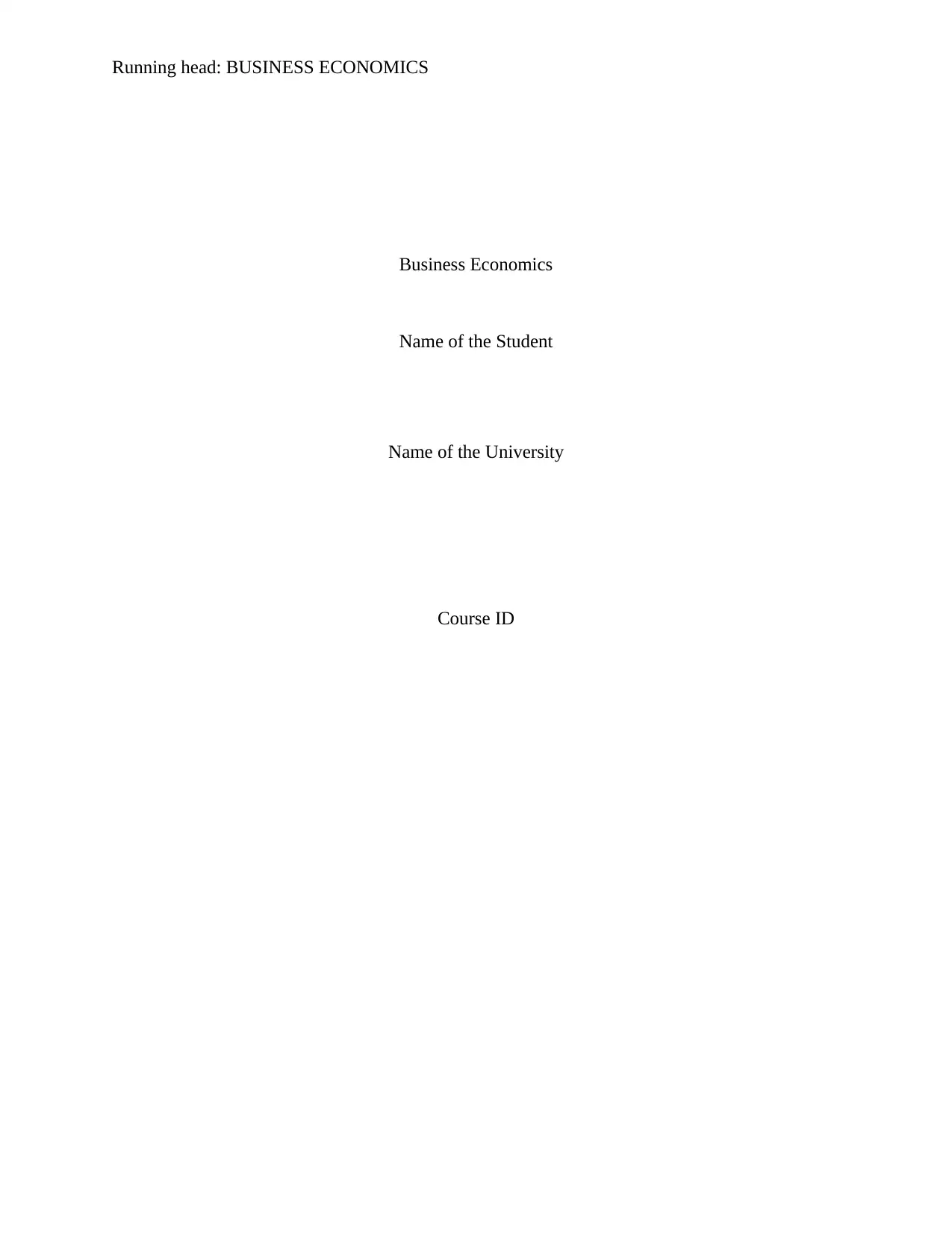
Running head: BUSINESS ECONOMICS
Business Economics
Name of the Student
Name of the University
Course ID
Business Economics
Name of the Student
Name of the University
Course ID
Paraphrase This Document
Need a fresh take? Get an instant paraphrase of this document with our AI Paraphraser
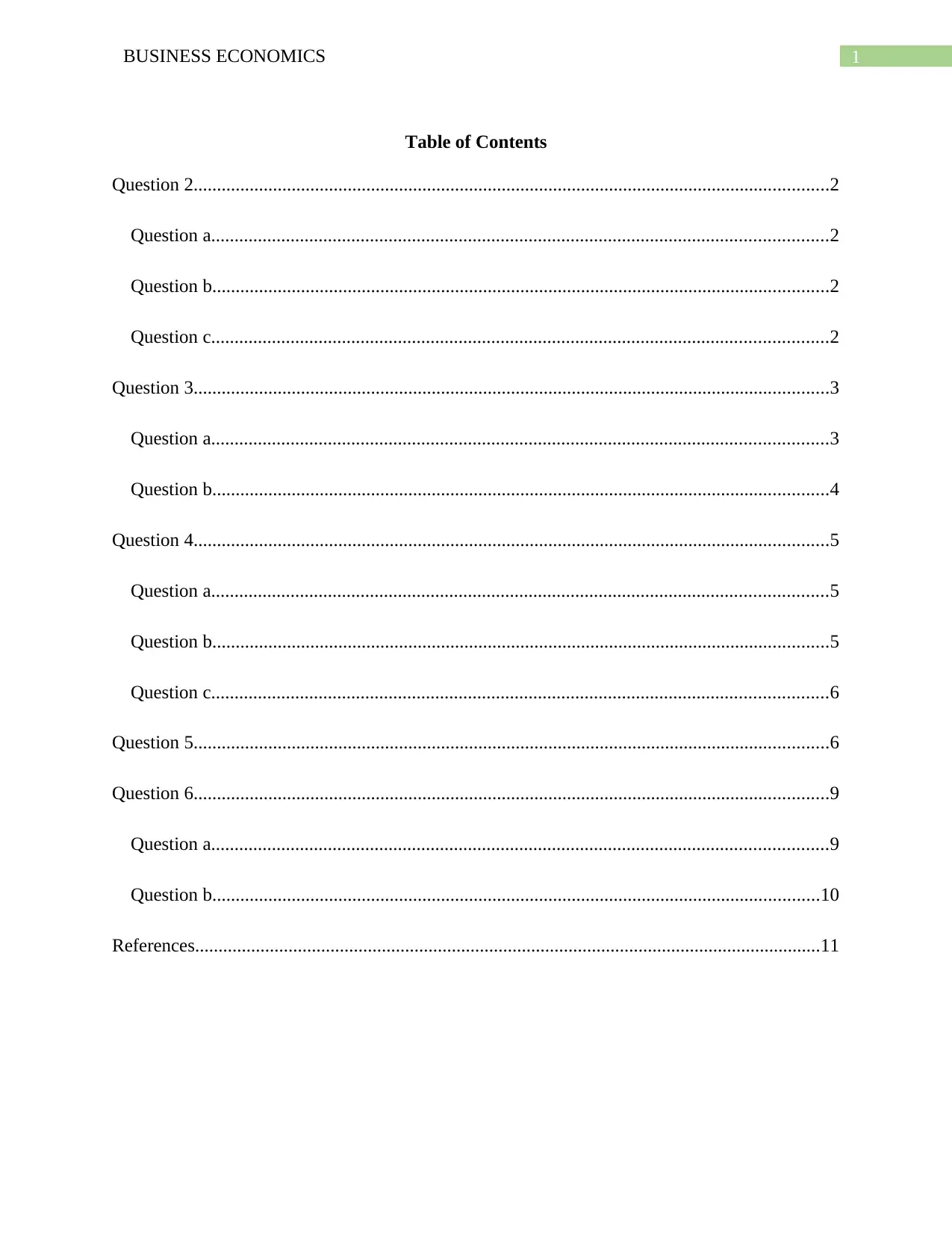
1BUSINESS ECONOMICS
Table of Contents
Question 2........................................................................................................................................2
Question a....................................................................................................................................2
Question b....................................................................................................................................2
Question c....................................................................................................................................2
Question 3........................................................................................................................................3
Question a....................................................................................................................................3
Question b....................................................................................................................................4
Question 4........................................................................................................................................5
Question a....................................................................................................................................5
Question b....................................................................................................................................5
Question c....................................................................................................................................6
Question 5........................................................................................................................................6
Question 6........................................................................................................................................9
Question a....................................................................................................................................9
Question b..................................................................................................................................10
References......................................................................................................................................11
Table of Contents
Question 2........................................................................................................................................2
Question a....................................................................................................................................2
Question b....................................................................................................................................2
Question c....................................................................................................................................2
Question 3........................................................................................................................................3
Question a....................................................................................................................................3
Question b....................................................................................................................................4
Question 4........................................................................................................................................5
Question a....................................................................................................................................5
Question b....................................................................................................................................5
Question c....................................................................................................................................6
Question 5........................................................................................................................................6
Question 6........................................................................................................................................9
Question a....................................................................................................................................9
Question b..................................................................................................................................10
References......................................................................................................................................11
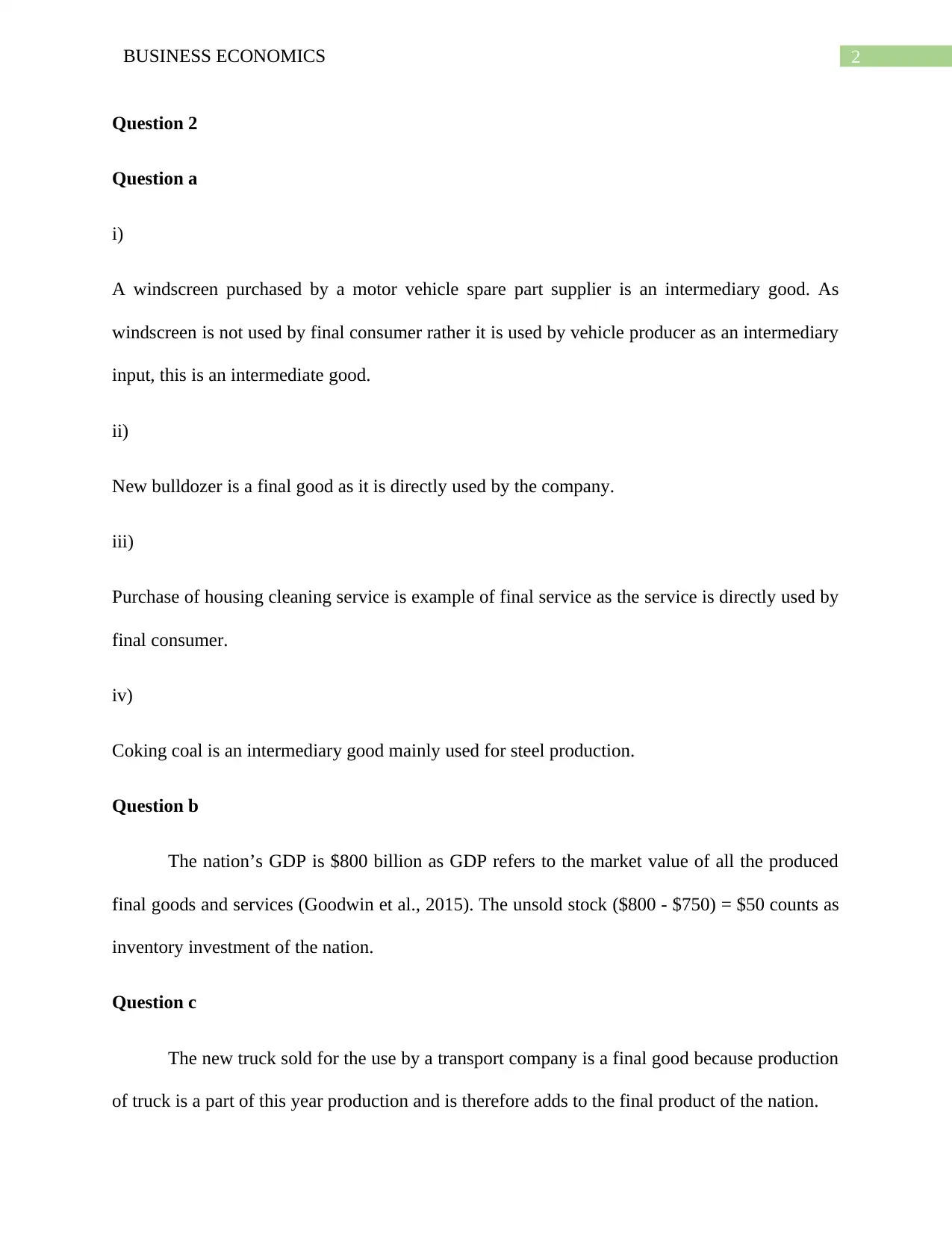
2BUSINESS ECONOMICS
Question 2
Question a
i)
A windscreen purchased by a motor vehicle spare part supplier is an intermediary good. As
windscreen is not used by final consumer rather it is used by vehicle producer as an intermediary
input, this is an intermediate good.
ii)
New bulldozer is a final good as it is directly used by the company.
iii)
Purchase of housing cleaning service is example of final service as the service is directly used by
final consumer.
iv)
Coking coal is an intermediary good mainly used for steel production.
Question b
The nation’s GDP is $800 billion as GDP refers to the market value of all the produced
final goods and services (Goodwin et al., 2015). The unsold stock ($800 - $750) = $50 counts as
inventory investment of the nation.
Question c
The new truck sold for the use by a transport company is a final good because production
of truck is a part of this year production and is therefore adds to the final product of the nation.
Question 2
Question a
i)
A windscreen purchased by a motor vehicle spare part supplier is an intermediary good. As
windscreen is not used by final consumer rather it is used by vehicle producer as an intermediary
input, this is an intermediate good.
ii)
New bulldozer is a final good as it is directly used by the company.
iii)
Purchase of housing cleaning service is example of final service as the service is directly used by
final consumer.
iv)
Coking coal is an intermediary good mainly used for steel production.
Question b
The nation’s GDP is $800 billion as GDP refers to the market value of all the produced
final goods and services (Goodwin et al., 2015). The unsold stock ($800 - $750) = $50 counts as
inventory investment of the nation.
Question c
The new truck sold for the use by a transport company is a final good because production
of truck is a part of this year production and is therefore adds to the final product of the nation.
⊘ This is a preview!⊘
Do you want full access?
Subscribe today to unlock all pages.

Trusted by 1+ million students worldwide
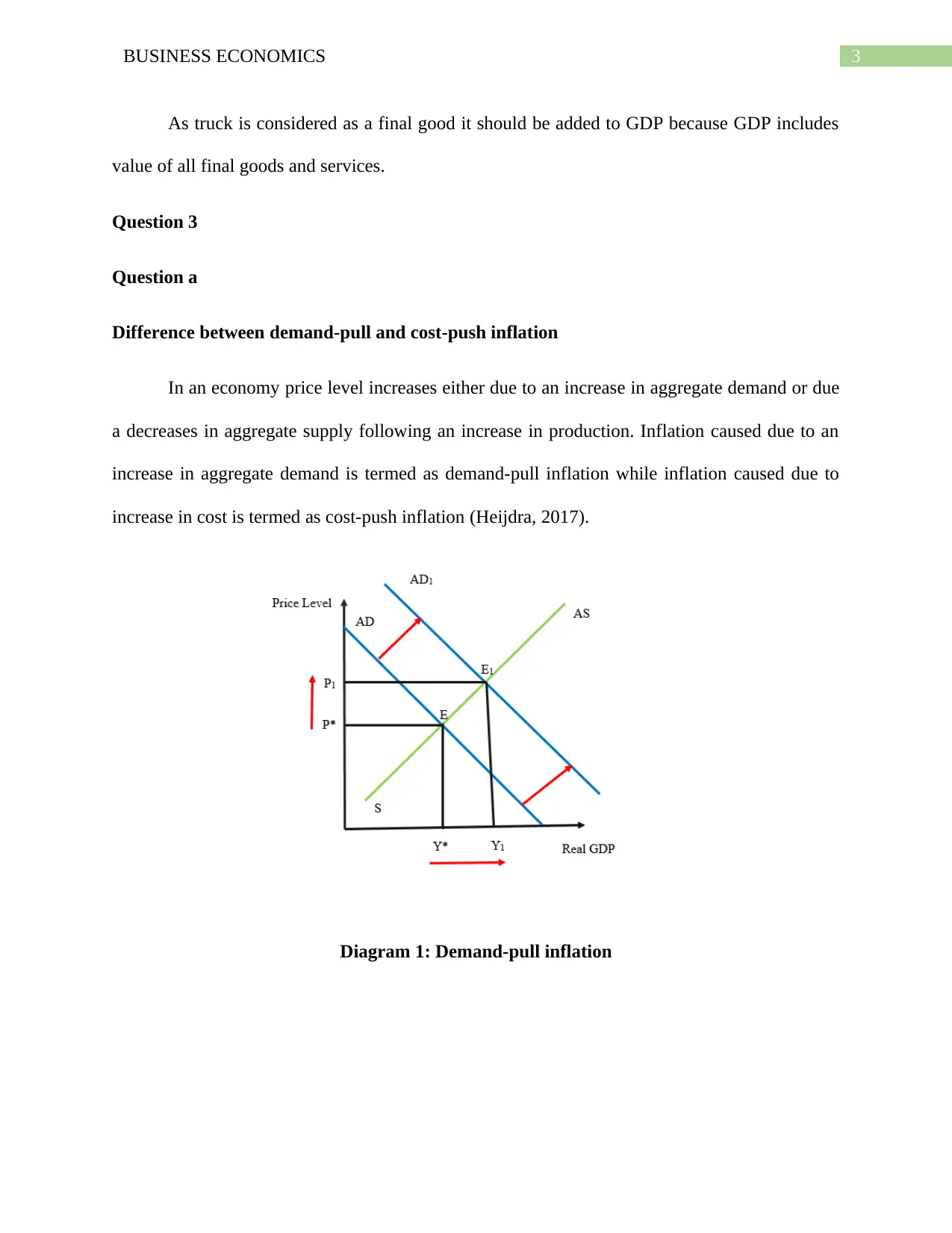
3BUSINESS ECONOMICS
As truck is considered as a final good it should be added to GDP because GDP includes
value of all final goods and services.
Question 3
Question a
Difference between demand-pull and cost-push inflation
In an economy price level increases either due to an increase in aggregate demand or due
a decreases in aggregate supply following an increase in production. Inflation caused due to an
increase in aggregate demand is termed as demand-pull inflation while inflation caused due to
increase in cost is termed as cost-push inflation (Heijdra, 2017).
Diagram 1: Demand-pull inflation
As truck is considered as a final good it should be added to GDP because GDP includes
value of all final goods and services.
Question 3
Question a
Difference between demand-pull and cost-push inflation
In an economy price level increases either due to an increase in aggregate demand or due
a decreases in aggregate supply following an increase in production. Inflation caused due to an
increase in aggregate demand is termed as demand-pull inflation while inflation caused due to
increase in cost is termed as cost-push inflation (Heijdra, 2017).
Diagram 1: Demand-pull inflation
Paraphrase This Document
Need a fresh take? Get an instant paraphrase of this document with our AI Paraphraser
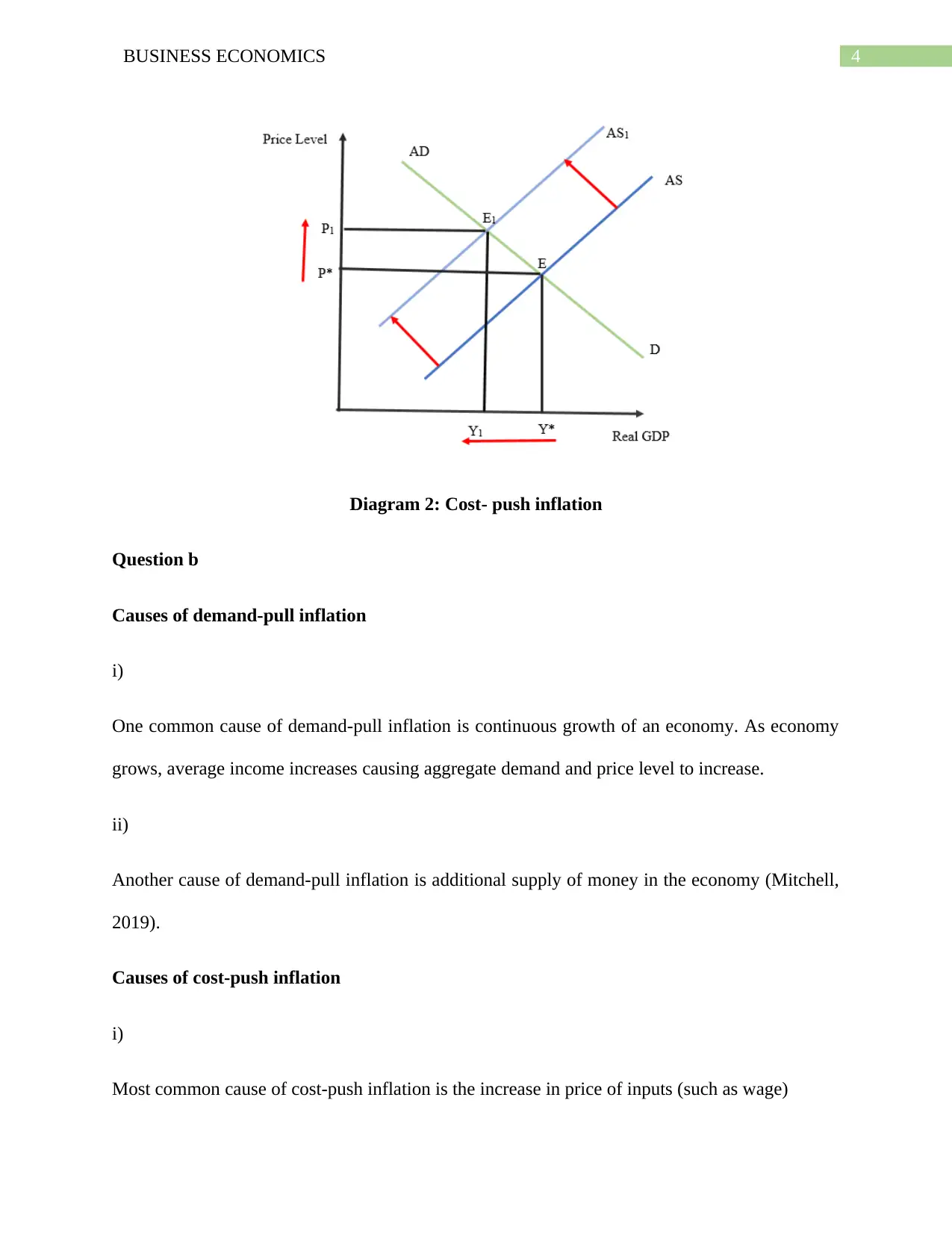
4BUSINESS ECONOMICS
Diagram 2: Cost- push inflation
Question b
Causes of demand-pull inflation
i)
One common cause of demand-pull inflation is continuous growth of an economy. As economy
grows, average income increases causing aggregate demand and price level to increase.
ii)
Another cause of demand-pull inflation is additional supply of money in the economy (Mitchell,
2019).
Causes of cost-push inflation
i)
Most common cause of cost-push inflation is the increase in price of inputs (such as wage)
Diagram 2: Cost- push inflation
Question b
Causes of demand-pull inflation
i)
One common cause of demand-pull inflation is continuous growth of an economy. As economy
grows, average income increases causing aggregate demand and price level to increase.
ii)
Another cause of demand-pull inflation is additional supply of money in the economy (Mitchell,
2019).
Causes of cost-push inflation
i)
Most common cause of cost-push inflation is the increase in price of inputs (such as wage)
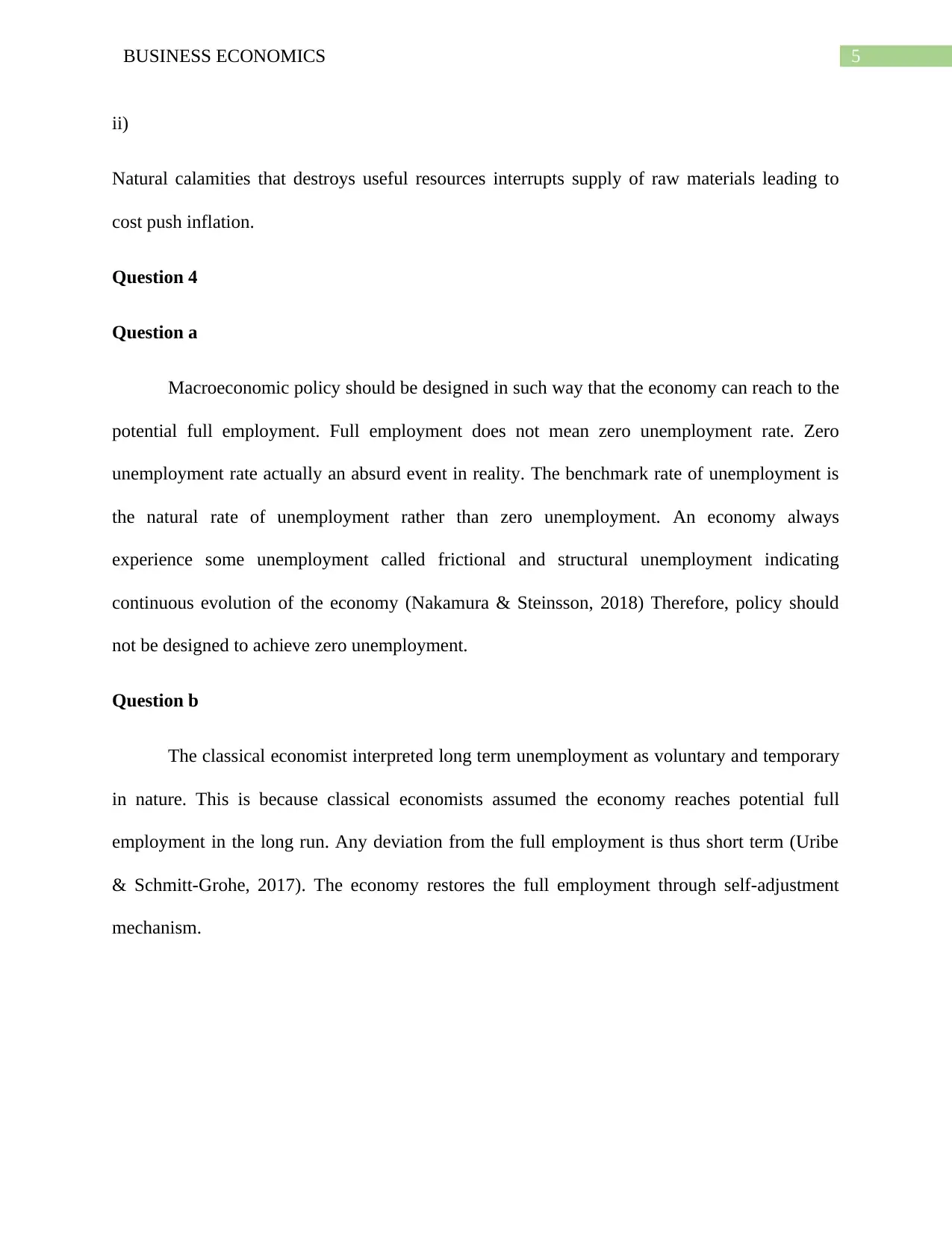
5BUSINESS ECONOMICS
ii)
Natural calamities that destroys useful resources interrupts supply of raw materials leading to
cost push inflation.
Question 4
Question a
Macroeconomic policy should be designed in such way that the economy can reach to the
potential full employment. Full employment does not mean zero unemployment rate. Zero
unemployment rate actually an absurd event in reality. The benchmark rate of unemployment is
the natural rate of unemployment rather than zero unemployment. An economy always
experience some unemployment called frictional and structural unemployment indicating
continuous evolution of the economy (Nakamura & Steinsson, 2018) Therefore, policy should
not be designed to achieve zero unemployment.
Question b
The classical economist interpreted long term unemployment as voluntary and temporary
in nature. This is because classical economists assumed the economy reaches potential full
employment in the long run. Any deviation from the full employment is thus short term (Uribe
& Schmitt-Grohe, 2017). The economy restores the full employment through self-adjustment
mechanism.
ii)
Natural calamities that destroys useful resources interrupts supply of raw materials leading to
cost push inflation.
Question 4
Question a
Macroeconomic policy should be designed in such way that the economy can reach to the
potential full employment. Full employment does not mean zero unemployment rate. Zero
unemployment rate actually an absurd event in reality. The benchmark rate of unemployment is
the natural rate of unemployment rather than zero unemployment. An economy always
experience some unemployment called frictional and structural unemployment indicating
continuous evolution of the economy (Nakamura & Steinsson, 2018) Therefore, policy should
not be designed to achieve zero unemployment.
Question b
The classical economist interpreted long term unemployment as voluntary and temporary
in nature. This is because classical economists assumed the economy reaches potential full
employment in the long run. Any deviation from the full employment is thus short term (Uribe
& Schmitt-Grohe, 2017). The economy restores the full employment through self-adjustment
mechanism.
⊘ This is a preview!⊘
Do you want full access?
Subscribe today to unlock all pages.

Trusted by 1+ million students worldwide
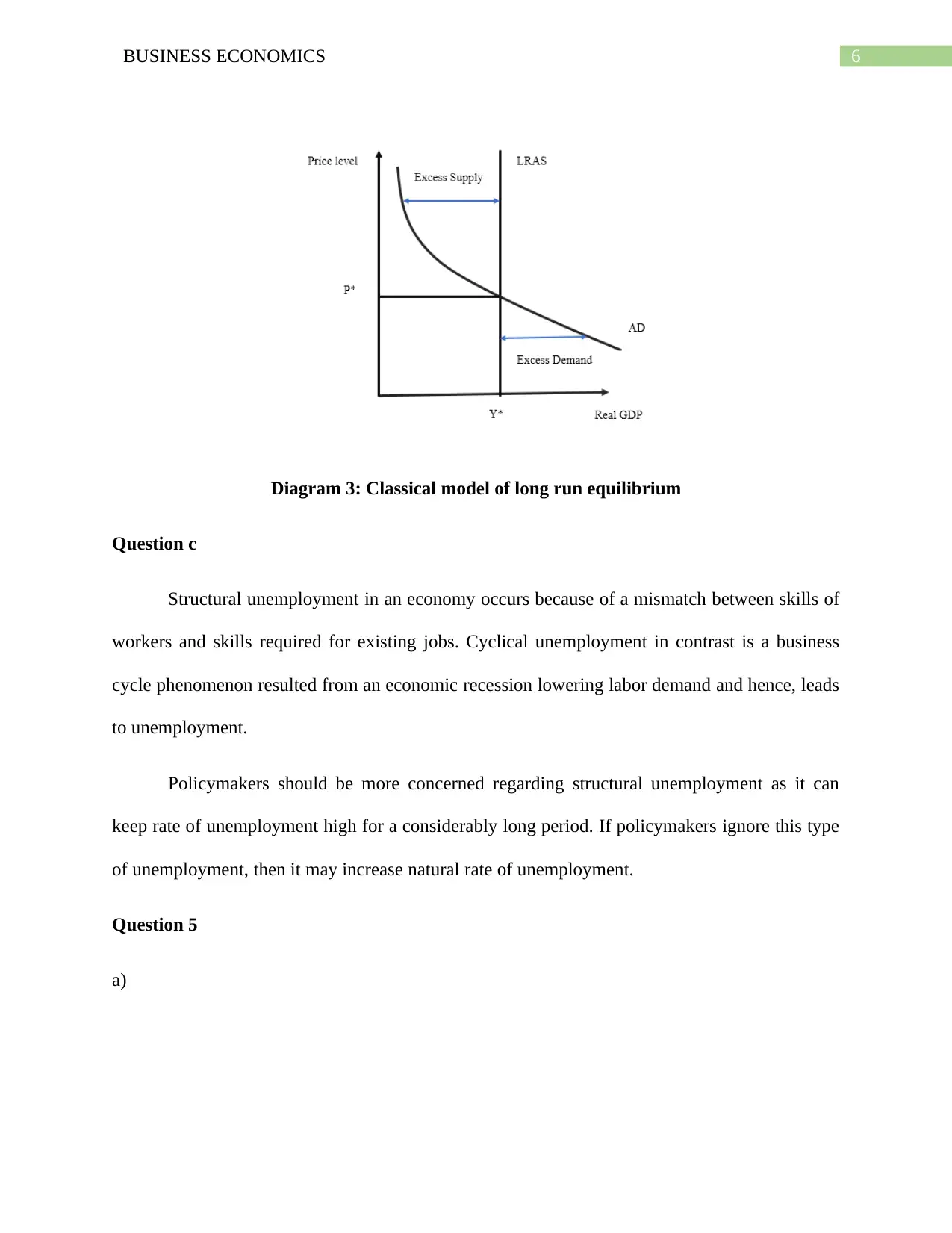
6BUSINESS ECONOMICS
Diagram 3: Classical model of long run equilibrium
Question c
Structural unemployment in an economy occurs because of a mismatch between skills of
workers and skills required for existing jobs. Cyclical unemployment in contrast is a business
cycle phenomenon resulted from an economic recession lowering labor demand and hence, leads
to unemployment.
Policymakers should be more concerned regarding structural unemployment as it can
keep rate of unemployment high for a considerably long period. If policymakers ignore this type
of unemployment, then it may increase natural rate of unemployment.
Question 5
a)
Diagram 3: Classical model of long run equilibrium
Question c
Structural unemployment in an economy occurs because of a mismatch between skills of
workers and skills required for existing jobs. Cyclical unemployment in contrast is a business
cycle phenomenon resulted from an economic recession lowering labor demand and hence, leads
to unemployment.
Policymakers should be more concerned regarding structural unemployment as it can
keep rate of unemployment high for a considerably long period. If policymakers ignore this type
of unemployment, then it may increase natural rate of unemployment.
Question 5
a)
Paraphrase This Document
Need a fresh take? Get an instant paraphrase of this document with our AI Paraphraser
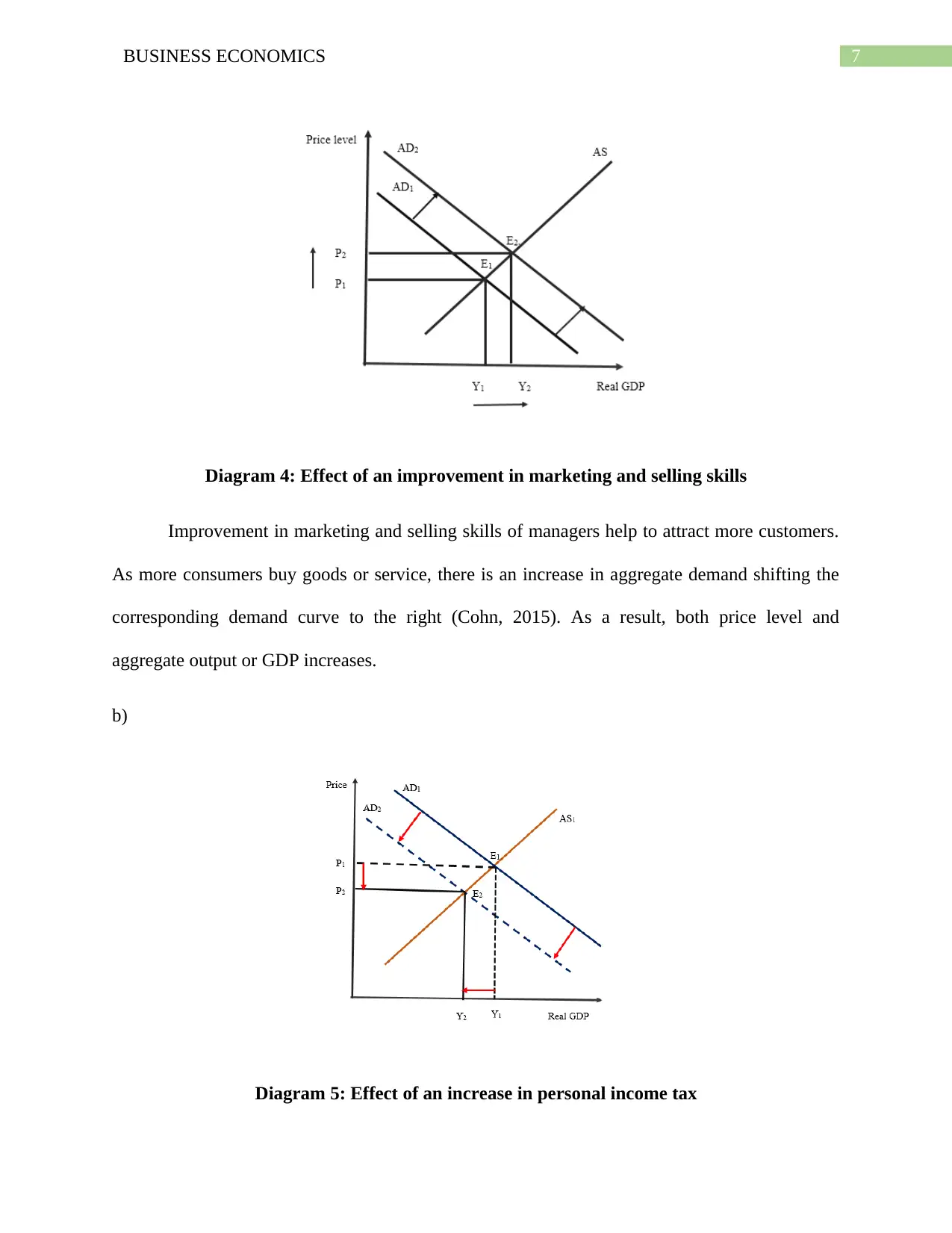
7BUSINESS ECONOMICS
Diagram 4: Effect of an improvement in marketing and selling skills
Improvement in marketing and selling skills of managers help to attract more customers.
As more consumers buy goods or service, there is an increase in aggregate demand shifting the
corresponding demand curve to the right (Cohn, 2015). As a result, both price level and
aggregate output or GDP increases.
b)
Diagram 5: Effect of an increase in personal income tax
Diagram 4: Effect of an improvement in marketing and selling skills
Improvement in marketing and selling skills of managers help to attract more customers.
As more consumers buy goods or service, there is an increase in aggregate demand shifting the
corresponding demand curve to the right (Cohn, 2015). As a result, both price level and
aggregate output or GDP increases.
b)
Diagram 5: Effect of an increase in personal income tax
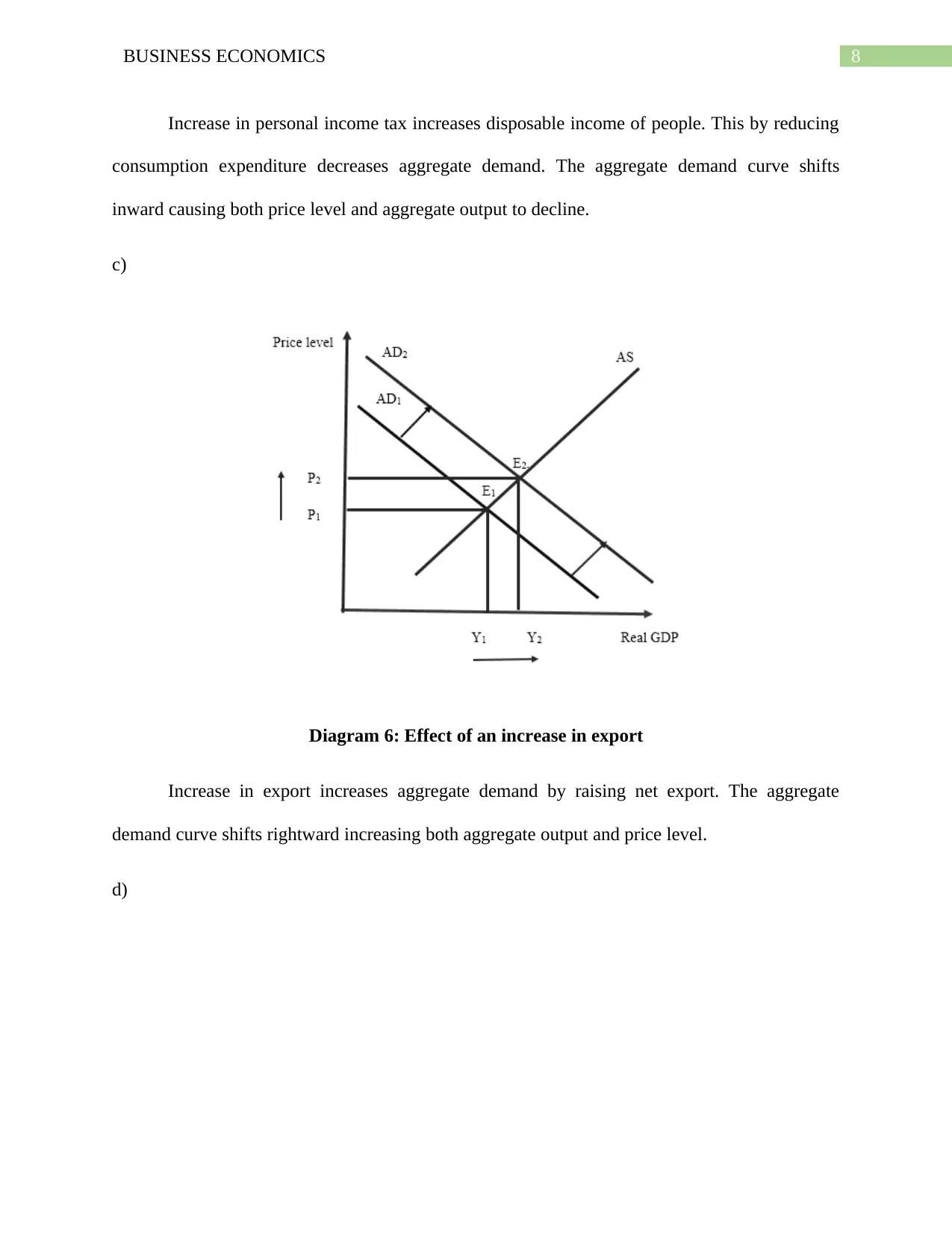
8BUSINESS ECONOMICS
Increase in personal income tax increases disposable income of people. This by reducing
consumption expenditure decreases aggregate demand. The aggregate demand curve shifts
inward causing both price level and aggregate output to decline.
c)
Diagram 6: Effect of an increase in export
Increase in export increases aggregate demand by raising net export. The aggregate
demand curve shifts rightward increasing both aggregate output and price level.
d)
Increase in personal income tax increases disposable income of people. This by reducing
consumption expenditure decreases aggregate demand. The aggregate demand curve shifts
inward causing both price level and aggregate output to decline.
c)
Diagram 6: Effect of an increase in export
Increase in export increases aggregate demand by raising net export. The aggregate
demand curve shifts rightward increasing both aggregate output and price level.
d)
⊘ This is a preview!⊘
Do you want full access?
Subscribe today to unlock all pages.

Trusted by 1+ million students worldwide
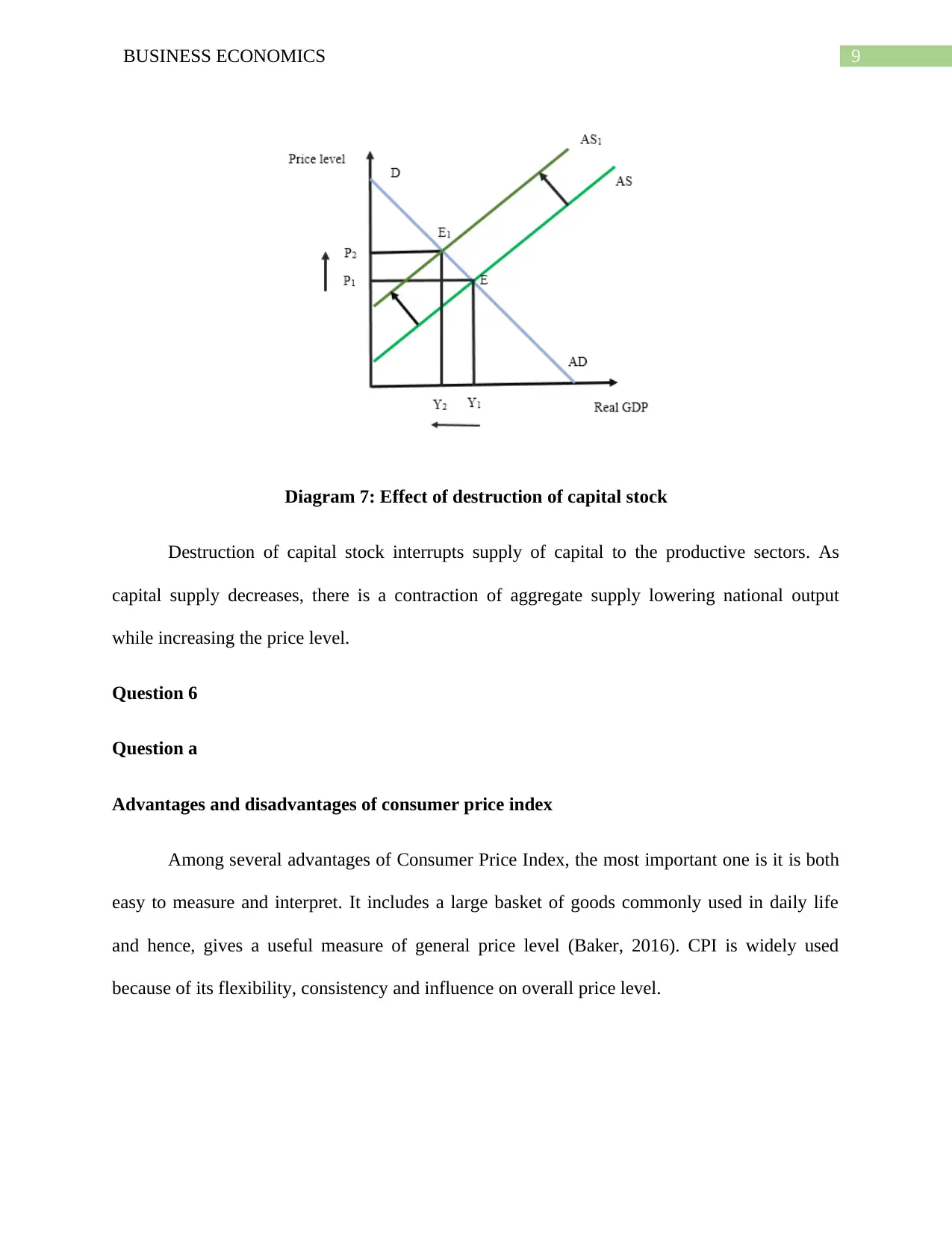
9BUSINESS ECONOMICS
Diagram 7: Effect of destruction of capital stock
Destruction of capital stock interrupts supply of capital to the productive sectors. As
capital supply decreases, there is a contraction of aggregate supply lowering national output
while increasing the price level.
Question 6
Question a
Advantages and disadvantages of consumer price index
Among several advantages of Consumer Price Index, the most important one is it is both
easy to measure and interpret. It includes a large basket of goods commonly used in daily life
and hence, gives a useful measure of general price level (Baker, 2016). CPI is widely used
because of its flexibility, consistency and influence on overall price level.
Diagram 7: Effect of destruction of capital stock
Destruction of capital stock interrupts supply of capital to the productive sectors. As
capital supply decreases, there is a contraction of aggregate supply lowering national output
while increasing the price level.
Question 6
Question a
Advantages and disadvantages of consumer price index
Among several advantages of Consumer Price Index, the most important one is it is both
easy to measure and interpret. It includes a large basket of goods commonly used in daily life
and hence, gives a useful measure of general price level (Baker, 2016). CPI is widely used
because of its flexibility, consistency and influence on overall price level.
Paraphrase This Document
Need a fresh take? Get an instant paraphrase of this document with our AI Paraphraser
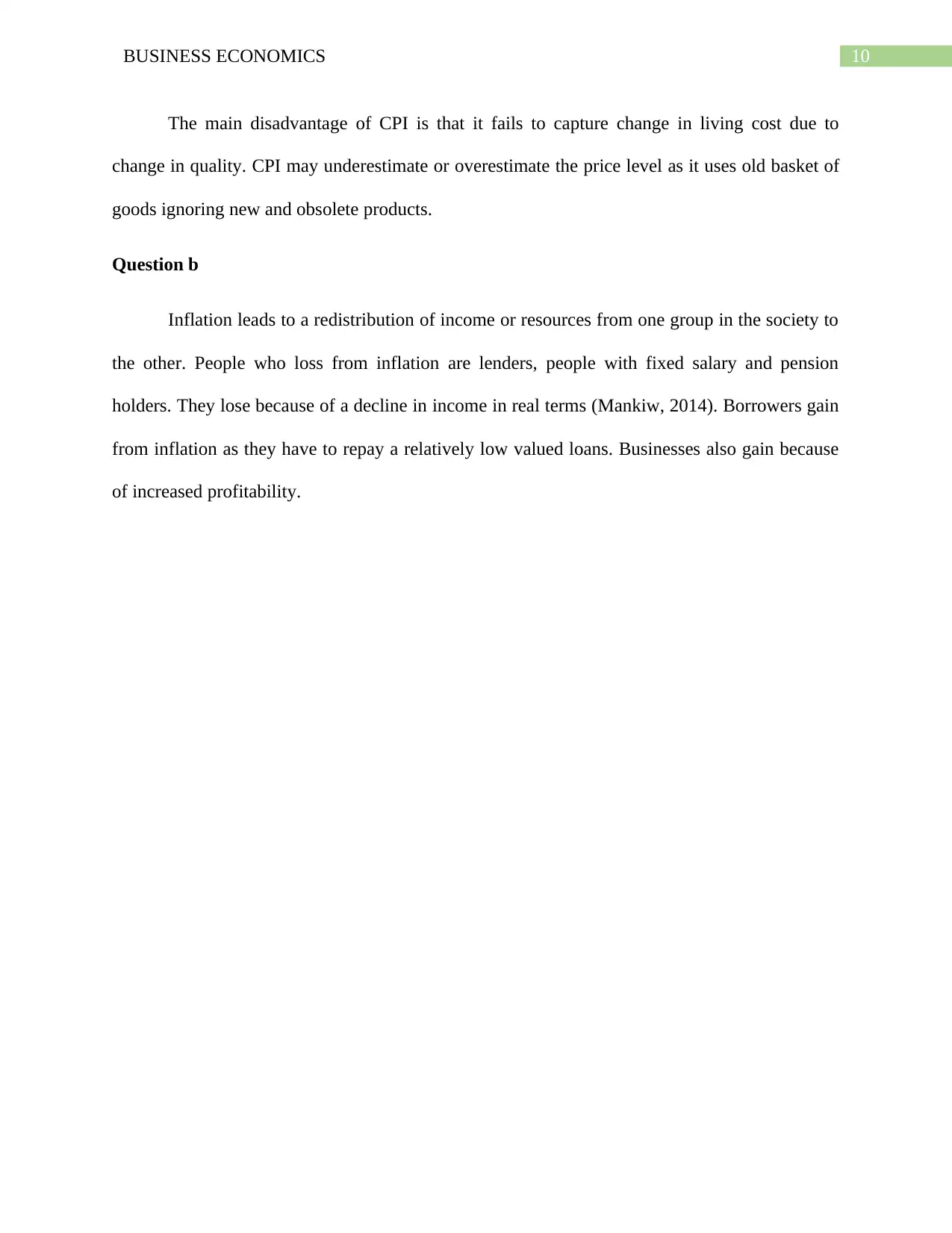
10BUSINESS ECONOMICS
The main disadvantage of CPI is that it fails to capture change in living cost due to
change in quality. CPI may underestimate or overestimate the price level as it uses old basket of
goods ignoring new and obsolete products.
Question b
Inflation leads to a redistribution of income or resources from one group in the society to
the other. People who loss from inflation are lenders, people with fixed salary and pension
holders. They lose because of a decline in income in real terms (Mankiw, 2014). Borrowers gain
from inflation as they have to repay a relatively low valued loans. Businesses also gain because
of increased profitability.
The main disadvantage of CPI is that it fails to capture change in living cost due to
change in quality. CPI may underestimate or overestimate the price level as it uses old basket of
goods ignoring new and obsolete products.
Question b
Inflation leads to a redistribution of income or resources from one group in the society to
the other. People who loss from inflation are lenders, people with fixed salary and pension
holders. They lose because of a decline in income in real terms (Mankiw, 2014). Borrowers gain
from inflation as they have to repay a relatively low valued loans. Businesses also gain because
of increased profitability.
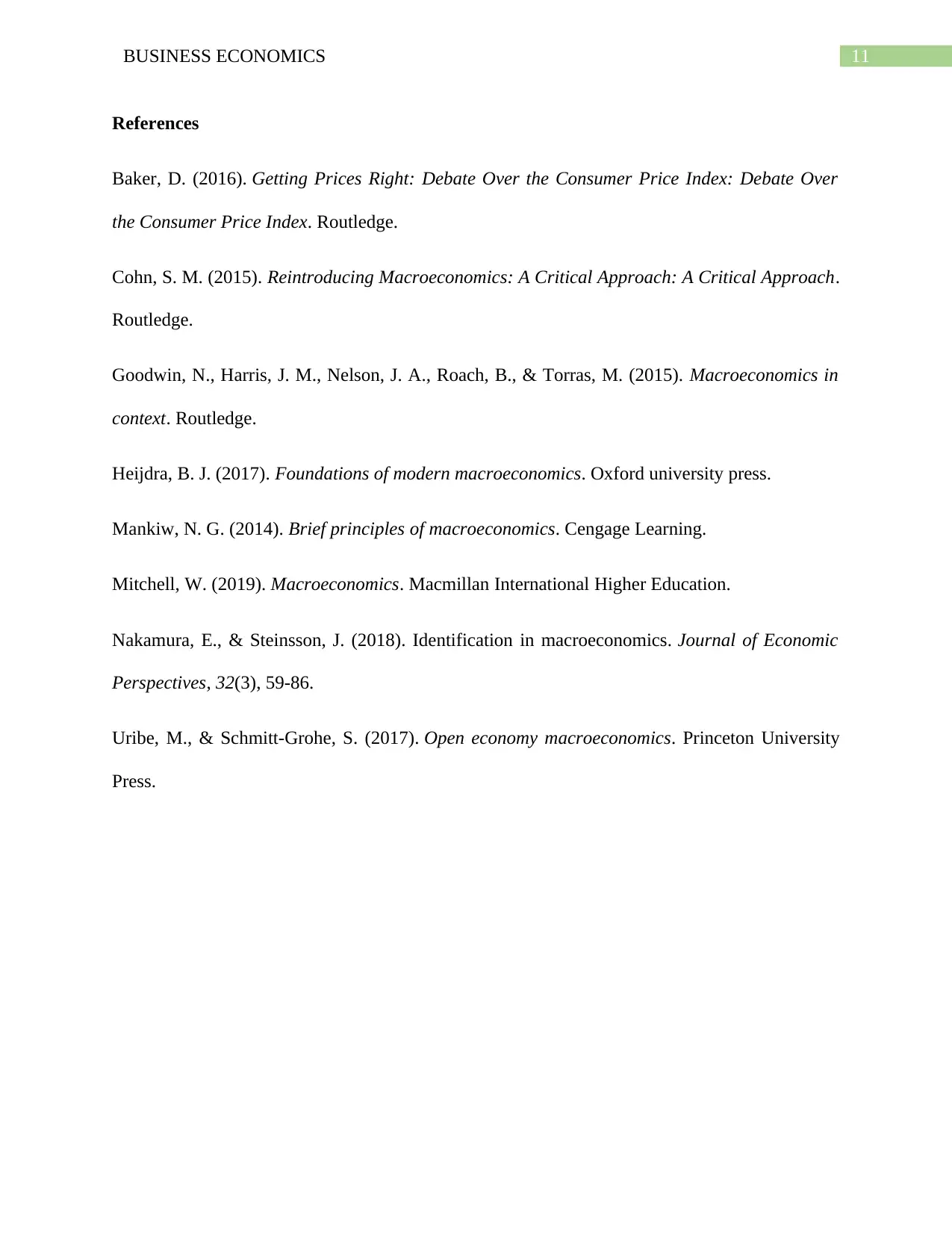
11BUSINESS ECONOMICS
References
Baker, D. (2016). Getting Prices Right: Debate Over the Consumer Price Index: Debate Over
the Consumer Price Index. Routledge.
Cohn, S. M. (2015). Reintroducing Macroeconomics: A Critical Approach: A Critical Approach.
Routledge.
Goodwin, N., Harris, J. M., Nelson, J. A., Roach, B., & Torras, M. (2015). Macroeconomics in
context. Routledge.
Heijdra, B. J. (2017). Foundations of modern macroeconomics. Oxford university press.
Mankiw, N. G. (2014). Brief principles of macroeconomics. Cengage Learning.
Mitchell, W. (2019). Macroeconomics. Macmillan International Higher Education.
Nakamura, E., & Steinsson, J. (2018). Identification in macroeconomics. Journal of Economic
Perspectives, 32(3), 59-86.
Uribe, M., & Schmitt-Grohe, S. (2017). Open economy macroeconomics. Princeton University
Press.
References
Baker, D. (2016). Getting Prices Right: Debate Over the Consumer Price Index: Debate Over
the Consumer Price Index. Routledge.
Cohn, S. M. (2015). Reintroducing Macroeconomics: A Critical Approach: A Critical Approach.
Routledge.
Goodwin, N., Harris, J. M., Nelson, J. A., Roach, B., & Torras, M. (2015). Macroeconomics in
context. Routledge.
Heijdra, B. J. (2017). Foundations of modern macroeconomics. Oxford university press.
Mankiw, N. G. (2014). Brief principles of macroeconomics. Cengage Learning.
Mitchell, W. (2019). Macroeconomics. Macmillan International Higher Education.
Nakamura, E., & Steinsson, J. (2018). Identification in macroeconomics. Journal of Economic
Perspectives, 32(3), 59-86.
Uribe, M., & Schmitt-Grohe, S. (2017). Open economy macroeconomics. Princeton University
Press.
⊘ This is a preview!⊘
Do you want full access?
Subscribe today to unlock all pages.

Trusted by 1+ million students worldwide
1 out of 12
Related Documents
Your All-in-One AI-Powered Toolkit for Academic Success.
+13062052269
info@desklib.com
Available 24*7 on WhatsApp / Email
![[object Object]](/_next/static/media/star-bottom.7253800d.svg)
Unlock your academic potential
Copyright © 2020–2025 A2Z Services. All Rights Reserved. Developed and managed by ZUCOL.





